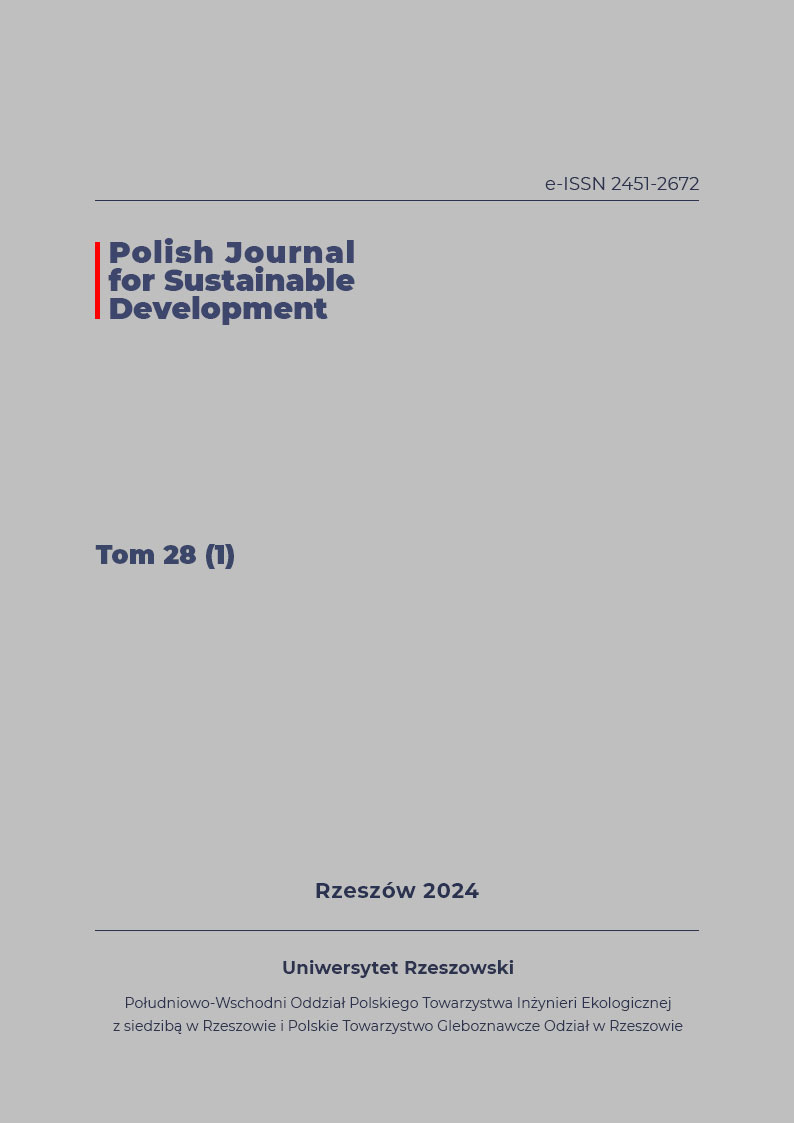Optymalizacja i walidacja metody oznaczania polichlorowanych bifenyli w glebie
DOI:
https://doi.org/10.15584/pjsd.2024.28.1.9Słowa kluczowe:
polichlorowane bifenyle, gleba, zanieczyszczenia, optymalizacja, walidacjaAbstrakt
Polichlorowane bifenyle (PCB) są to syntetyczne związki aromatyczne produkowane w dużych ilościach na całym świecie od lat trzydziestych XX wieku. Ich synteza została zabroniona w latach 70 XX wieku. Związki te miały szerokie zastosowanie między innymi jako płyny dielektryczne w kondensatorach i transformatorach, smary czy plastyfikatory. Ze względu na właściwości tych związków, takie jak odporność na degradację chemiczną i długi okres półtrwania (od 3 do 40 lat), stanowią one trwałe zanieczyszczenia środowiska. Najwyższe ich ilości znajdują się w glebie, jednak można je oznaczyć również w powietrzu, osadach, wodzie, roślinach, a nawet organizmach żywych. Celem pracy była optymalizacja i walidacja metody oznaczania kongenerów PCB 10, 28, 138, 153 i 180 w glebie. W procesie optymalizacji metody, testowano trzy odczynniki do ekstrakcji oraz dwa rodzaje sorbentów do oczyszczania. Walidację przeprowadzono na dwóch poziomach wzbogacenia w celu określenia odzysku i precyzji metody. Zoptymalizowaną i zwalidowaną metodę zastosowano do analizy zawartości wybranych kongenerów PCB w próbkach rzeczywistych pobranych z terenu Podkarpacia. Na podstawie przeprowadzonych badań wykazano, że najlepszym odczynnikiem do ekstrakcji PCB z gleby jest heksan, zaś sorbentem do oczyszczania Florisil. Stężenie PCB 10, 28, 52, 138 i 153 w analizowanych próbkach rzeczywistych było poniżej granicy oznaczalności (LOQ<0,005 mg/kg). PCB 180 oznaczono na poziomie 0,007 mg/kg w glebie pobranej z terenu obok linii kolejowych w Głuchowie.
Downloads
Bibliografia
Ahmad I., Weng J., Stromberg A.J., Hilt J.Z., Dziubla T. 2019. Fluorescence Based Detection of Poly Chlorinated Biphenyls (PCBs) in Water Using Hydrophobic Interaction. The Analyst. 144(2). 677-684. DOI:10.1039/c8an00867a.
Aken B.V., Correa P. A., Schnoor J. L. 2010. Phytoremediation of Polychlorinated Biphenyls: New Trends and Promises†. Environmental Science & Technology. 44(8). 2767-2776. DOI:10.1021/es902514d.
Elabbas L.E., Westerholm E., Roos R., Halldin K., Korkalainen M., Viluksela M., Håkansson H. 2013. Non-dioxin-like polychlorinated biphenyls (NDL-PCBs) in foods: exposure and health hazards. Persistent Organic Pollutants and Toxic Metals in Foods. 215-260. DOI:10.1533/9780857098917.2.215.
Erickson M.D., Kaley R.G. 2010. Applications of polychlorinated biphenyls. Environmental Science and Pollution Research. 18(2). 135-151. DOI:10.1007/s11356-010-0392-1.
Jin W., Otake M., Eguchi A., Sakurai K., Nakaoka H., Watanabe M., Mori C. 2017. Dietary Habits and Cooking Methods Could Reduce Avoidable Exposure to PCBs in Maternal and Cord Sera. Scientific Reports. 7(1). DOI:10.1038/s41598-017-17656-9.
Kaw H.Y., Kannan N. 2016. A Review on Polychlorinated Biphenyls (PCBs) and Polybrominated Diphenyl Ethers (PBDEs) in South Asia with a Focus on Malaysia. Reviews of Environmental Contamination and Toxicology. 242. 153-181. DOI:10.1007/398_2016_14.
Kiani A., Arabameri M., Shariatifar N., Mehraie A., Tooryan F., Ghanbariasad A., Shahsavari S. 2023. Analysis of polychlorinated biphenyls (PCBs) in dairy products by modified QuEChERS/GC-QqQ-MS/MS method: A risk assessment study. Food Sci Nutr. 10.11(6). 2895-2906. DOI: 10.1002/fsn3.3269.
Kumar B., Verma V.K., Singh S.K., Kumar S., Sharma C.S., Akolkar A.B. 2014. Polychlorinated biphenyls in residential soils and their health risk and hazard in an industrial city in India. Journal of Public Health Research. 3(2). DOI:10.4081/jphr.2014.252.
Moukas A.I., Thomaidis N.S., Calokerinos A.C. 2014. Determination of polychlorinated biphenyls by liquid chromatography-atmospheric pressure photoionization-mass spectrometry. Journal of Mass Spectrometry. 49(11). 1096-1107. DOI:10.1002/jms.3427.
Olatunji O.S. 2019. Evaluation of selected polychlorinated biphenyls (PCBs) congeners and dichlorodiphenyltrichloroethane (DDT) in fresh root and leafy vegetables using GC-MS. Scientific Reports. 9(1). 538. DOI:10.1038/s41598-018-36996-8.
Rozporządzenie Ministra Gospodarki z dnia 24 czerwca 2002 r. w sprawie wymagań w zakresie wykorzystywania i przemieszczania substancji stwarzających szczególne zagrożenie dla środowiska oraz wykorzystywania i oczyszczania instalacji lub urządzeń, w których były lub są wykorzystywane substancje stwarzające szczególne zagrożenie dla środowiska. Dz.U. 2002 nr 96 poz. 860. [dok. elektr. https://isap.sejm.gov.pl/isap.nsf/download.xsp/WDU20020960860/O/D20020860.pdf data wejścia 24.06.2024].
Rozporządzenie Ministra Środowiska z dnia 1 września 2016 r. w sprawie sposobu prowadzenia oceny zanieczyszczenia powierzchni ziemi. Dziennik Ustaw Rzeczypospolitej Polskiej 2016, Poz. 1395. [dok. elektr. http://isap.sejm.gov.pl/isap.nsf/download.xsp/WDU20160001395/O/D20161395.pdf data wejścia 24.06.2024].
Starek A. 2001. Polichlorowane bifenyle - toksykologia – ryzyko zdrowotne. Roczniki Państwowego Zakładu Higieny. 52(3). 187-201.
Vorkamp K., Odsbjerg L., Langeland M., Mayer P. 2016. Utilizing the partitioning properties of silicone for the passive sampling of polychlorinated biphenyls (PCBs) in indoor air. Chemosphere. 160. 280-286. DOI: 10.1016/j.chemosphere.2016.06.054.
Witczak A., Abdel-Gawad H. 2012. Comparison of organochlorine pesticides and polychlorinated biphenyls residues in vegetables, grain and soil from organic and conventional farming in Poland. Journal of Environmental Science and Health. Part B. 47(4). 343-354. DOI:10.1080/03601234.2012.646173.
Wojtowicz K., Jakubowicz P. 2019. Opracowanie metodyki oznaczania polichlorowanych bifenyli w próbkach gleb. Nafta-Gaz. 75. 420-429. DOI: 10.18668/NG.2019.07.06.
Pobrania
Opublikowane
Numer
Dział
Licencja
Prawa autorskie (c) 2024 Polish Journal for Sustainable Development

Utwór dostępny jest na licencji Creative Commons Uznanie autorstwa – Użycie niekomercyjne – Bez utworów zależnych 4.0 Międzynarodowe.


